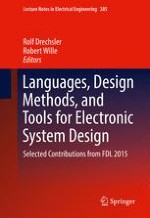This book brings together a selection of the best papers from the eighteenth edition of the Forum on specification and Design Languages Conference (FDL), which took place on September 14-16, 2015, in Barcelona, Spain. FDL is a well-established international forum devoted to dissemination of research results, practical experiences and new ideas in the application of specification, design and verification languages to the design, modeling and verification of integrated circuits, complex hardware/software embedded systems, and mixed-technology systems.
